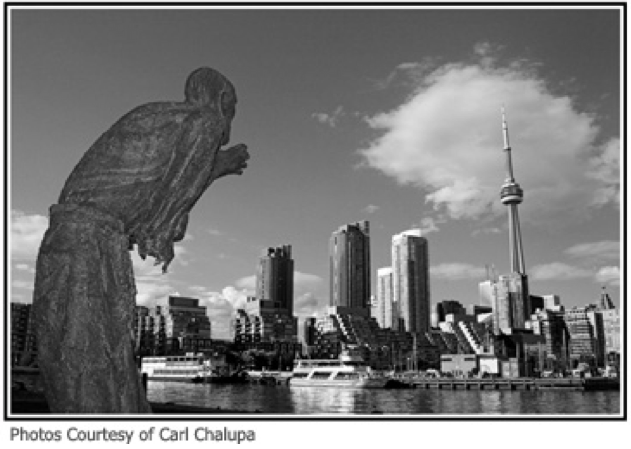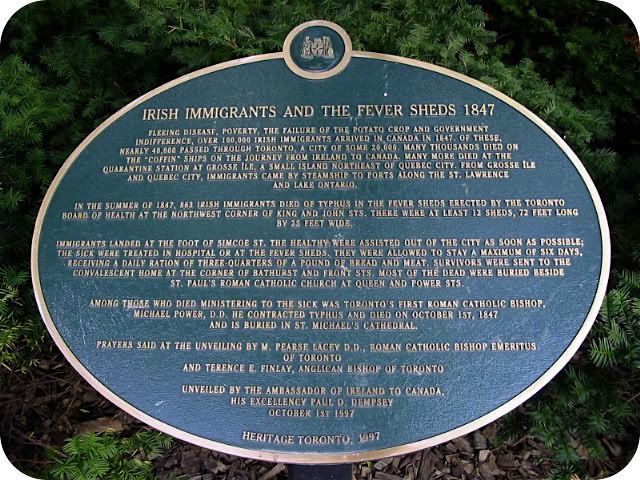John Henry Dunn was a wealthy businessman and receiver-general of Upper Canada (1820-1841) and of Canada (1841-43), who endured considerable criticism for his cavalier handling of government finances. (He also was the father of Alexander Dunn, first Canadian recipient of the Victoria Cross, for bravery at 'the Charge of the Light Brigade' at Balaclava.)
In 1841, Dunn was elected to the first Legislative Assembly of United Canada for Toronto (by a vote total of 495 over 436 votes for George Monro. "Reform, on the part of the Government and people" was his slogan).
 |
| The approximate location of John Dunn's house. Fort York to the left, Oasis to the south, Victoria Square bottom right. |
On his lot -- opposite the future Oasis location -- Dunn built a new house (presumably replacing the previous one storey structure), described thusly:
"On the death of Mrs. Dunn, a new three-storey house of brick, with wings, was built for Mr. Dunn in 1835 by Mr. John G. Howard, the architect, at the north-west corner of Front and Bathurst streets. […] The house at Front and Bathurst street was rented by the government and occupied as quarters for the officers at the garrison. It afterwards came into the possession of John Dickey. Later it was occupied as an agricultural implement factory, and still later by John Doty."
- J. Ross Robertson's Landmarks of Toronto (vol.1), 1895, p 264.(Take note of the name; Doty is a seminal figure we'll encounter again…)
In the summer of 1847, the Irish Famine prompted a desperate migration of over 38 thousand Irish refugees to Toronto (whose population at the time was less than 30 thousand). This massive influx severely challenged local officials, and would form one of Toronto's first civic crises.
 |
| Ireland Memorial Park commemorates the crisis |
Ships packed with thousands of Irish emigrants made their way across the Atlantic and down the St. Lawrence. These passengers were often ravaged by typhus. One commentator compared the overcrowding, lack of sanitation, and health care on the lake ships to conditions on board slave ships from Africa to the United States. As a result of the terrible conditions, typhoid fever killed many of the arriving emigrants.
 |
| Heritage Toronto Plaque on the Fever Sheds of 1847 |
Passengers coming to Toronto were forced to disembark at "Dr. Rees' Wharf", near the current site of the Metro Convention Centre. An Emigrant Hospital and 'fever sheds' were constructed at King and John, but were quickly overrun. The crisis deepened when George Grasett, the Chief Medical Officer at the Emigrant Hospital, died of fever on July 18. Panic over a possible epidemic began to spread in the city.
In August, the Board of Public Health and city authorities rented a brick building on the corner of Bathurst and Front Streets... from none other than John Henry Dunn. This building and its stables would notoriously serve as a Convalescent Hospital -- essentially an overflow triage zone for Emigrant Hospital survivors.
In The Famine Migration of 1847 and Toronto, Mark McGowan writes,
"Dunn’s property would serve as a Convalescent Hospital, to which patients in recovery at the Emigrant Hospital could be moved. The erection of this new facility provided the convalescing patient with a healthier environment for recovery and offered a more efficient use of space in the “Fever” hospital. Shortly after opening, the Convalescent Hospital would house over 300 patients daily. From there, patients would either be released to continue their trek into the interior, be sent back to the Emigrant Hospital should they suffer a “relapse,” (usually bad cases of diarrhea), or, if they were widows and orphans, sent to the “House of Refuge,” a former barracks at Bathurst and Queen Streets."Ireland Park, located on the south east corner of Bathurst Quay and just west of Rees' wharf and south of the fever sheds, commemorates the tragedy. Mark McGowan's gripping Death or Canada
Coincidentally, in the early 1990s I briefly lived in one of the row houses on the south side of Niagara just west of Bathurst. At the time I had no idea of the area's deep history. The archeological assessment performed during the preparation for the now-dead Fort York Pedestrian Bridge observes: "The rear yard areas of late nineteenth-century row housing have potential for the survival of limited remains of the circa 1835-1852 Officers' Quarters."
Guess I should have done some digging in the back yard! All we ever did was sit in the back and drink beer.
George Monro's Scottish Cottager - McGrath
George Monro, the 6th Mayor of Toronto -- who was defeated by John Henry Dunn in the 1841 legislative assembly elections -- also owned property extremely close by (if not in fact at) the Oasis site, on the north east lot at Front and Bathurst. Robertson's description:
"Mr. Monro extended his hobby for gardening beyond the surroundings of his dwelling. He bought a plot of about half an acre on Front street, between Portland and Bathurst streets, and here in a little cottage he installed a Scotch gardener named McGrath, whom he had brought from Scotland. Here Mr. Monro would pass his evenings occasionally, while McGrath paced up and down playing the bagpipes. He afterwards sold this property…"
- Robertson's Landmarks of Toronto (vol.1), 1895 J. Ross Robertson, p 264.Ever wonder why the music is so loud at Oasis? Now you know -- it's to dispel the ghostly bagpipes of Gardener McGrath! [what eventually became of Monro’s cottage I was unable to discover]
Read the next section:
You're reading: Farewell to Rock Oasis, the secret history of my home climbing gym.
Table of Contents
Like, Share, or Comment on this post!

